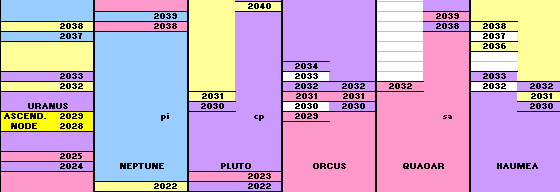|
Years 1860 - 2100. Click the small diagram for opening it.

In the diagram we have used a Vernal Point correction of 1,00368 degrees per 72 years.
Updated Sep 07, 2017
We are all worried about global warming. The intensified storms and the long periods of drought during the last few
years have shown us some of the consequences it can have. At the moment of writing, the extremely strong
hurricane Irma is moving
towards Cuba and Florida.
Many kinds of forecasts and calculations have been made about climate developments over the next few years, and besides them,
we now have the diagram of future weather developments based on events throughout the whole solar system and cosmos.
The diagram contains important information about notable cooling in temperature around 2030, after a short very hot period.
This information considers the NATURAL VARIATION of climate and it DOES NOT remove our responsibility for reducing the manmade carbon
dioxide emissions.

Risky heat peak
The warmest peak of the natural temperatures seems to occur during the years 2018-2024. Humankind's activities, however, have produced a hazardous
addition into this naturally warm period. Furthermore, when we look at the years 2016-2024 in the light of
the recent high temperatures in the USA, Southern Europe and the Middle East, as well as the alarmingly melting polar areas or tundra
with its methane emissions, we have a reason to be really worried. The consequences of this short period of time may be faster than we understand.

The New Mini Ice Age
The 2030's may witness some severely cold periods, and will probably mark a real decline in the temperature curve.
Between 2040-2050 the temperatures will rise again for a while (Saturn,
Uranus, Neptune, Pluto, Eris) and Pluto will continue in the light area until
2061 (warmth/light combination). It would appear that Quaoar's and Makemake's cold earth/light-transition periods are scheduled
between 2055-2060, and Sedna's coldest period will start after 2060. The corresponding previous earth-light transition of Sedna occurred between
1460-1470, which was the coldest low point of the first huge temperature drop
of the previous mini Ice Age. Thus the next mini Ice Age,
forecast by the Russian Dr. Abdusamatov and some other scientists, may be completely possible during these cold periods of time and it may last
until around 2070. However some warming factors occur already earlier: The light-planet Eris transitions to element warmth around 2045 and couldness-causing
Haumea moves into the milder water area in 2048.

'Magic Gates'
Let's have a look at the increasing warmth during last decades from the point of view of the whole solar system. What can we
find beyond the manmade increase in temperature?
In 1997 the dwarf planet Orcus, which is an exponent of the etheric element warmth, moved into the cosmic area of etheric element warmth.
In 1998 into the element warmth moved also the planet Saturn, representing warmth as well. This point of time was called the 'magic gate'
by climatologist Julia Cole, because the reason for this sudden increase of warmth was unknown.
The previous 'magic gate', according to her, opened in 1976, at the time when 'water planet' Makemake moved into the warmth area, and a
significant leap of warmth was noticed on the faraway coral atoll of Maiana in the Pacific nation of Kiribati.
(Tim Flannery: The Weather Makers)
In the beginning of the 70s Sedna, the strongest cooler of the Solar system, had already moved into the area of etheric element warmth and from this point of time also a remarkable
warming of the climate has been recorded. Due to the slow orbit of these planets, not until 2009-2011 have Makemake and Sedna moved away from the
etheric element warmth into the cooler earth element.
From warmth towards coldness
Through a 'magic gate' we can also go in the direction of cooling temperatures. In the beginning of the 2030s Jupiter, Saturn, Uranus,
Pluto and Haumea will all make the cold earth/light transition about the same time. Around that time Makemake and Sedna will still be moving in the
element earth and Orcus will be making a warmth/earth transition. Neptune will be moving in the water area and will strengthen the rains.
Much will depend on the
faster moving near planets: how much warmth will be gained from the cosmic factors and when. Also, the ascending node of Uranus in 2029
may cause unexpected coldness in addition to strong thunderstorms. Of course the light element will also have a warming effect, but combined
with the element earth it will mostly add to the coldness, especially at night.
From imbalance to balance
With all the waste on the ground, emissions of industry and traffic, the huge amount of plastic in the oceans etc. the Nature has become imbalanced.
We have made it imbalanced. By drying wetlands we have made floods worse. We have paved enormous areas of land preventing water absorption. We have
caused erosion and deforestation on unimaginable scale. We have made it impossible for Nature to even manage the normal weather cycles in the
natural way. Now we have to face the consequences. What can we do?
Our task in this critical situation is very clear: we have to clean the Earth including the ground, the seas and the air - immediately- each of us working
where we can. We also can plant and sow different trees and plants everywhere it just is possible. We can ask Nature to work WITH US and we can expect this
co-operation to be fruitful.
We are 7,6 billion people, we can do it.
Quintile72.net JJK
|










